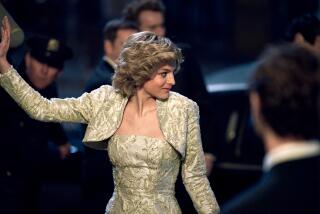PBS’ Civil War series ‘Mercy Street’ moves drama from battlefield to hospital
RICHMOND, Va. — On a sweltering June afternoon, women in heavy hooped skirts and men in thick wool suits bustled around a historic building in the former capital of the Confederacy as it was transformed into a Civil War hospital for the new PBS drama “Mercy Street.”
Despite the commitment to period authenticity on set, evident in the artfully distressed walls, sullied cots and dozens of background players in bloodied uniforms, the cast and crew looked forward to the minutes between takes when the air conditioning was switched on, allowing them to appreciate at least one very modern comfort.
See more of Entertainment’s top stories on Facebook >>
Dubbed “‘Gone With the Wind’ meets ‘MASH’” by its creative team, “Mercy Street” is inspired by real events and, in a novel twist for a Civil War series, features two female protagonists who are volunteer nurses at the hospital — Mary Phinney, a staunch Northern abolitionist (Mary Elizabeth Winstead) and Emma Green (Hannah James), a genteel Southern belle from a wealthy slave-owning family.
The series, which premieres Sunday on PBS, presents a fresh perspective on this great American cataclysm by focusing not on battlefields and bayonets but on the drama at a luxury hotel-turned-hospital in Union-occupied Alexandria, Va., in the early days of the war.
“Mercy Street’s” ensemble also includes Josh Radnor as a pioneering, morphine-addicted surgeon, McKinley Belcher as a free black man with a natural talent for medicine and Gary Cole as Emma’s entrepreneurial father, who refuses to sign an oath of loyalty to the Union. Director Ridley Scott and former “ER” show runner David Zabel executive produce the series, which is PBS’ first original scripted drama in more than a decade.
With the end of the wildly popular “Downton Abbey” in sight, the public broadcaster is betting that the perennial fascination with this era, particularly among its viewers — Ken Burns’ “The Civil War” remains the network’s most-watched series after all — will help establish “Mercy Street” as its next marquee drama.
“The themes are completely relatable, and they’re relevant today,” said executive producer Lisa Quijano Wolfinger on the show’s set. This was no mere platitude: Five days earlier, nine black churchgoers had been gunned down in a racially motivated attack in Charleston, S.C., — the very city where the Civil War began — sparking a heated national debate about the Confederate flag.
The series was created by Wolfinger, a documentary filmmaker who originally planned to make a docudrama about Civil War medicine. She turned to Zabel for help marrying the medical science with the narrative drama — something he knows plenty about, having written 45 episodes of “ER” over the course of eight seasons.
The duo originally envisioned a one-off special, but Beth Hoppe, chief programming executive at PBS, saw the potential for an ongoing series.
“She and I always talked about the fact that PBS was stuck in the hamster wheel of just acquiring British drama,” Wolfinger recalled, referring to scripted programming such as “Sherlock,” “Call the Midwife” and of course “Downton Abbey.” “It’s time for Americans to tell American stories, as far as I’m concerned.”
In the course of her research, Wolfinger came across the memoir of a woman with a mouthful of a name — Mary Phinney, the Baroness von Olnhausen — who’d volunteered as a nurse at Alexandria’s Mansion House Hotel. Owned by the wealthy Green family, the hotel was converted into a hospital during the war.
The Greens’ daughter Emma, whose sweetheart was a Confederate spy, tended to wounded Southerners at the hospital. The surrounding city of Alexandria was also a destination for escaped slaves — or “contraband,” as they were designated by the Union — on their way to freedom in the North.
The discovery of Mansion House, with so many diverse people coming together in a single space, represented a “light bulb moment,” according to Zabel.
“I didn’t want to get into cliche binary oppositions of North and South, black and white,” he said. “I felt like in this place with all of these various agendas bumping up against each other, you could really explore this moment in a much more variegated way, diverse way. It didn’t reduce itself to certain simplistic attitudes and perspectives.”
Another key inspiration was Louisa May Alcott’s “Hospital Sketches,” a collection of letters the “Little Women” novelist and abolitionist wrote during her time as a Union nurse. Wolfinger was excited by the opportunity to create a series about interesting and messy women. “I took the gamble, because I wanted to make TV that I wanted to watch,” she said. The hospital setting also conveniently provided a way to tell a Civil War story without having to film expensive battle sequences, which would have been exceedingly difficult on a PBS budget.
This being PBS, historical accuracy was of paramount importance. The network enlisted a panel of advisors, including military historian James McPherson and Anya Jabour, an expert in Southern women of the Civil War era. “We are held to a higher standard, and we should be,” said Hoppe, noting with pride that documentarian Burns had given the series a ringing endorsement.
On location at the Laburnum House, a Neoclassical revival building in Richmond standing in for Alexandria’s Mansion House, the series’ medical consultant Dr. Stanley Burns shows Radnor a complicated surgical procedure using a model abdomen. Burns, a collector of early medical photography and devices, gently scolds Radnor for referring to a tenaculum as a shepherd’s hook: “That’s like referring to rocket propulsion in 1862!”
For all the carnage it created, the Civil War also led to critical innovations in the world of medicine. These changes are reflected in Radnor’s character, Jedediah Foster, who trained in Europe and is an early adopter of new-fangled inventions like painkillers and hypodermic needles that are viewed with skepticism by some of his peers. “He is a cynic about human nature but an idealist when it comes to medicine,” explained the actor, best known for his work as Ted Mosby in the long-running sitcom “How I Met Your Mother.”
In the chaos of wartime, many women saw an opportunity to step out of their traditional gender roles, particularly by volunteering as nurses, Wolfinger said. “They’re flying in the face of social convention by being in an all-male environment. Those constraints all are temporarily broken, and so you’ve got these women busting through the door, and trying to make a difference in a very difficult world.”
This is particularly true for Emma Green, played by James in her first professional role. In the series pilot, Emma treks through the filthy streets of Alexandria dressed in a pristine white dress, enormous hoop skirt and perfect spiral curls. The Scarlett O’Hara look is wildly ill-suited for work at the hospital, where rats scurry between beds filled with maimed, battle-scarred young men.
For James, who grew up on a farm in nearby Madison County, Virginia — just 10 minutes from the town where the real Emma eventually settled with her husband — “Mercy Street” represented a kind of homecoming. And while she made a point of trying to understand her character’s Southern pride, she was more troubled by a conversation with a cab driver who discovered she was working on a Civil War series and asked if she was fighting “for the right side.” (Hint: Not the guys in blue.)
“This seems like it was ages ago, but the issues are so prevalent,” she said. “People feel like they’re so affected — are still affected — by what happened years and years ago.”
More to Read
The complete guide to home viewing
Get Screen Gab for everything about the TV shows and streaming movies everyone’s talking about.
You may occasionally receive promotional content from the Los Angeles Times.






